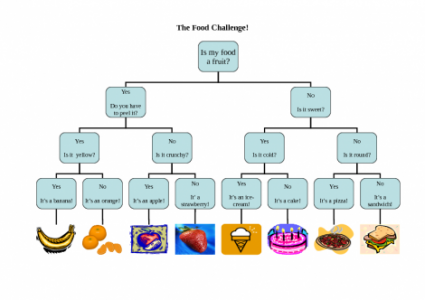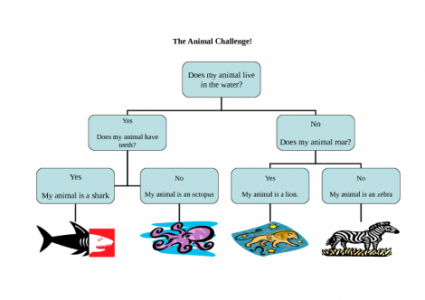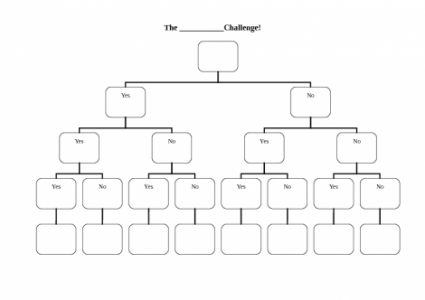Search
User login
Topic “Individual”
Contains activities for individuals (one on one).
1-6 Grid
Grid containing the numbers 1 to 6. This can be used in a number of games - for example this emotions game.
Created 18 October 2012; updated 30 April 2022.
Use two key word instructions in everyday activities
| Activity/strategy name and materials required | How to do the activity | Key principles for doing the activity and comments |
|---|---|---|
| Making a cup of tea - telling you what to do Kitchen with everything appropriate for making a cup of tea. You don't need to have them out and ready though - finding the stuff can be part of the activity. | 1. Sit in the kitchen at an empty table and say you want to make a cup of tea - but you don't know what to do (or have forgotten what to do); 2. See if the person suggests getting something - e.g. teabag or cup. If the person suggests something, e.g. teabag, ask where you can find it. See if they can tell you - e.g. "cupboard" - but if not, give then some suggestions - e.g. "in the cupboard or in the fridge?" - have a look in the fridge if they suggest that. If the person doesn't suggest anything, give a funny choice, e.g. shall I get a cup or a paint brush - if they suggest "paint brush", get one and then look really confused when you have it - see if they can correct you, or if there is not paint brush to find, look equally confused. Get a cup even if they don't prompt you to get one (as if you've suddenly remembered!) 3. As you go along, try to get the person to extend the language - but don't try to get them to repeat, also try to avoid asking leading questions (for example avoid asking "shall I stir the tea now?"). For example if you have a tea bag and a cup, and they say "cup", indicating that you put something in the cup, put something else in the cup - e.g. a pen. If they then say teabag, do something with the teabag - but don't put it in the cup. At this point they may try to put the two words together, e.g. "teabag...cup". If not, you can give them a choice. Try the following: "teabag in the cup or pen in the cup" (you might get a response of "teabag" in which case put it somewhere - not in the cup); or "teabag in the cup or pen in the bag" or "pen in the bag or teabag in the cup" (easiest because the target phrase is last). | If the person is not familiar with making a cup of tea already, you should spend some time doing this - talking them through what you are doing as you make the tea. The key principle here is to give the minimum amount of prompting. You will need to adjust the level of prompting so that the person is a little bit challenged by the task - but not so much that there are long pauses (what constitutes a long pause will vary from person to person). As far as possible, you are trying to literally do what the person says - so if they say something that's potentially ambiguous, choose a more amusing interpretation of what they have said. The idea is that this activity should be really fun, and also prompt the person to try and add more information and be more accurate. |
| Everyday activities Whatever is required for the activity. Activities could include:
|
Understand and use ordinals (1st, 2nd, 3rd etc)
| Activity/strategy name and materials required | How to do the activity | Key principles for doing the activity and comments |
|---|---|---|
| Write it Writing materials |
| This works best 1:1. Use this activity only with a child who can read and write. With children with less good literacy skills, you will need to talk about what you are going to focus on, but miss out the written support. With children who can cope with larger numbers, you might want to go beyond 10, be careful to explain how numbers such as 21st, 22nd and 23rd are formed. |
| Line up None | This works best with a class or group. You may want to focus more on the front of the line. | |
| PE Equipment as required by the PE activity | This works best with a class. | |
| Small World Small world equipment, including several ‘people’. | This works best 1:1. This activity is more suited to younger children. | |
| Actions Equipment as required by the actions. Visual prompt cards if required. | This works best 1:1 or with a small group. Make sure you stress words such as “first”, “second” etc. Bear in mind the child’s auditory memory – the more instructions you give, the harder it will be to remember them. |
Learn new words
| Activity/strategy name and materials required | How to do the activity | Key principles for doing the activity and comments |
|---|---|---|
| Exploring words Written word with a picture Written sounds for beginning/ end of each word Visuals for the story Dictionary (maybe)
| Ideas you can use to help word learning - you do not need to use all of them, and some will work better than others for different children. 1. Introduce the written form of the word; 2. Say the word to the child and ask for repetition; 3. Ask the child to clap syllables on your or their hands, use prompting if necessary. Or alternatively they could tap the syllables out on pictures of drums (say four arranged in a row); 4. Ask if any other words rhyme with this new word (think of examples yourself) - you could take this in turns in a group; 5. Ask for beginning and ending sounds; 6. Tell the child a short story or anecdote, including the word as the main feature if possible - or work with the child to work a story out; 7. Give an explicit definition (school dictionary maybe - some dictionaries are more helpful than others for this!) and give context(s) preferably first one being the one used in the story as it’s familiar but make sure to offer other contexts; 8. Ask the child if they can put the word in a sentence/ tell a short story including the word; 9. If ability allows, ask the child if they know of any word which means a similar thing. | These activities help to build a child’s vocabulary with solid representations of words. It gives a child strategies to use when learning and remembering new words. It builds the child’s confidence on a topic, especially if taught before the relevant lesson. |
Number action rhymes
Below are some action number rhymes which you can use to develop children’s understanding of numbers and also encourage them to initiate and continue the song/interaction with you.
Remember to sing these songs a few times with your child and show them how to move their hands/body by modelling it yourself.
Communicating Phonics - Quick Reference
Background
The Communication Trust's publication "Communicating Phonics" was published to help teachers who are administering the Year 1 phonics screening check to children with speech language and communication needs (children with SLCN). Although this guidance was written with this check in mind, it also provides much useful information for developing literacy skills with this group of children.
The table below is reproduced from the reference table which comes from pages 12 - 16 of this guidance.
Communicating Phonics - Quick Reference
Created 13 June 2012; updated 6 December 2024.
Initiate a request for items to do a task
| Activity/strategy name and materials required | How to do the activity | Key principles for doing the activity and comments |
|---|---|---|
| Impossible task! Materials as needed, for example:
| Ask the child to carry out tasks without giving them the equipment they need. For example:
| If a child does not request anything, you can try to motivate the child to correct you or "help you", for example:
See also suggestions here: make a choice at snack time |
use switches to turn something on or off
| Activity/strategy name and materials required | How to do the activity | Key principles for doing the activity and comments |
|---|---|---|
| Keeping cool: learning to sustain an action Fan, (with optional ribbons attached) Mains switch control box | Configure the controller so that the fan is on as long as the switch is held down. Hold down the switch and let the child/adult feel the breeze. Let them do the same. | The child/adult should experience holding down the switch and feeling the breeze. On release the breeze stops. State, "On" and "Off" as you and the child/adult press and release the switch. |
| Learning to use a switch to turn a device on Fan (as above) | As either of you press the switch say, "on." When it stops say "off." Show them the effect of the breeze, blowing your hair or rubbing your arms because it is cold. | |
| Switching a device on and off (Do this in a subsequent session after the child/adult has understood the process in the above activity). A device to control, for example: fan toy computer monitor bubble machine | Let the child/adult turn the fan on and off modelling the vocabulary as you go. Reinforce this learning with different devices at different times and places. |
Make a choice using two switches
| Activity/strategy name and materials required | How to do the activity | Key principles for doing the activity and comments |
|---|---|---|
| Establishing motivators Items/activities the student may be interested in. Items/short activities the student is not interested in. |
| Don't use two things which are motivating for the student as you won't be able to tell whether they've succeeded in expressing a choice or not. |
| Establishing the switches to use Appropriate switches to use Typically you might start off with a couple of large recordable buttons (for example "Big Macs". You may have already established this with single switch work and established that they can make something happen with a single switch). | You may need to work with an occupational therapist to establish what type of switch a student can use - particularly if they have complex physical difficulties. | |
| Making choices Pair of switches Motivating and un-motivating items/activities (see the activity "establishing motivators" above) | If they don't press a switch you may need to:
Consistency of pressing Do they appear to be pressing one switch more than another, or do they appear to be choosing the switch randomly? Swapping the switches around from time to time will help you to know this. If they aren't consistent, you could try making the switches more different, for example:
You could also try:
|
Developing attention and listening skills through motivating activities
| Activity/strategy name and materials required | How to do the activity | Key principles for doing the activity and comments |
|---|---|---|
| Sensory Play - Sensory toys and materials for messy play (e.g. trays with sand/ cornflour and water/jelly). - The best toys are those that the child can manipulate easily to produce a result. | 1. Guide your child's hands and visual attention to toys/trays of material(s) that they can touch and look at. 2. Let your child explore the toys/materials in the tray and encourage them to investigate all their properties, stimulating all of the child's senses as far as possible (colour, smell, texture). 3. You may need to draw the child's attention back to the activity if the child becomes distracted. Use your voice to regain their attention (e.g. a drawn out "ohhhh!", or an intake of breath). | Do not continue with something the child has lost interest in, but wait a while before introducing another object. |
| Turn taking games - Ball / dark cloth - Your voice - to sing simple nursery rhymes that have an element of anticipation built in such as "Round and round the haystack, like a little mouse, one step, two step and into his little house". | This is a fun activity for you and the child to enjoy together. Use plenty of facial expression and your voice to gain and keep the child's attention. |
The Animal Challenge
Created 15 May 2012; updated 18 July 2015.
Blank 3 question challenge
Template for creating questions using a flowchart: see https://en.commtap.org/language-communication/develop-question-skills for ideas as to how you could use this.
Created 15 May 2012; updated 16 July 2015.
Support Commtap to keep it online
Thank you for visiting Commtap.
Please read this message as it is extremely important.
- Visitor donations mean we can continue to host over 1,000 free activities to support speech, language, and communication development.
- Visitor donations mean we can continue to provide free resources to address a wide range of communication needs, including limited speech or language, interaction challenges, and needs associated with conditions such as developmental language disorder, autism, and cerebral palsy.
- Visitor donations mean we can continue to provide resources to support the work of speech and language therapists, teachers, teaching assistants, parents, and carers.
- Visitor donations mean we can continue to provide the free key word sign dictionary (bks.org.uk) which has over 2,000 Makaton and Signalong signs.
We know that not everyone is able to afford to pay to access these resources, however, if you can, please make a donation to keep the site going.
Thank you
Google ads on this page are provided by Google Adsense - and their presence does not imply any endorsement by Commtap. Report a problem with an ad on this page. Log in (for free) to avoid seeing Google ads.






